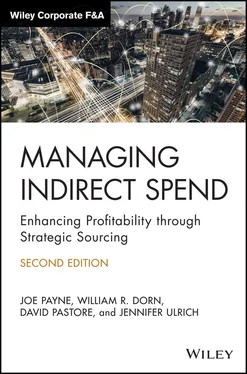The choice of sourcing and purchasing from a manufacturer versus a distributor comes down to three primary factors: cost, quantity, and service level. Most manufacturers prefer to sell their products in quantities of a truckload at a time; however, some may accept half‐truckload or even pallet‐load orders, depending on the market. If you believe the quantities you purchase of a particular product are a motivating factor to the manufacturing community, then you may want to consider including manufacturers in your supplier long list.
Conversely, if your quantities are low, or if you believe you require specific service levels, such as dedicated account management or same‐day deliveries, then you may want to focus your supplier list on distributors alone.
As a side note, many sourcing strategies include engaging with both distributors and manufacturers, even if the initiative ends with the decision to purchase through a distributor. For example, in the area of maintenance, repair, and operations (MRO) supplies, working with manufacturers to standardize the types of products being purchased and committing to a certain volume with those specific manufacturers may result in obtaining special pricing for your organization beyond what a distributor can offer. The distributor still delivers the product, with their markup on top of it, but the base price will be lower.
Another example is enterprise software acquisition, such as Microsoft licensing, or maintenance programs with hardware manufacturers, like Cisco. In both cases, it is common to negotiate directly with the manufacturer and then have the manufacturer require your selected supplier to pass on the negotiated prices. We discuss manufacturer and distributor collaborative strategies in greater detail in Chapter 20.
Group Purchasing Organizations (GPOs), Brokers, and Other Third Parties
GPOs, brokers, and other third parties can provide a wealth of market intelligence and give you access to pricing or services that are not normally accessible. The basic concept behind these types of organizations is that they receive a small markup (normally paid by their supplier) to bring that supplier new accounts or additional sales.
GPOs normally aggregate volume from several members in order to get lower pricing from suppliers and often provide account management and other enhanced services to those members across multiple categories of spend. Most GPOs are tied to one specific supplier for a particular category of spend. Alternatively, some have multiple suppliers for certain categories.
Brokers are experts in a particular market and can help identify the right supplier for you based on your specific requirements. They typically have relationships with multiple manufacturers and distributors, and some even warehouse and distribute products themselves.
Other third parties, such as manufacturer representatives, are paid to bring sales into organizations that do not have their own dedicated sales teams or organizations that want to supplement their internal sales team with additional resources. These third parties work with one or multiple manufacturers and across one or many types of products or services.
You should consider looking at third‐party options when developing a supplier long list. Pay particular attention to these options if you are unfamiliar with the category in question, lack resources, or if you feel the category adds little value to your organization and you hope to outsource its management.
UNDERSTANDING CURRENT MARKET CONDITIONS
Market conditions are comprised of the current trends or recent events going on in the marketplace. These include capacity issues, supplier consolidation or deconsolidation efforts, new regulatory changes, natural disasters, and political or socio‐economic changes. Often, these conditions can play a major role in the results of a Strategic Sourcing initiative.
Having a firm understanding of ongoing market conditions will help you solicit proposals from suppliers at the most advantageous time for your organization. For example, if markets are currently unstable or fluctuating dramatically, it is probably not the best time to request a price decrease from a current supplier. In addition, if product is scarce and capacity is unavailable, alternate suppliers are going to be less likely to provide you with a low price. Instead they may focus on ensuring supply for existing customers.
You would not, for example, want to approach your suppliers for discounts on oil‐based products during hurricane season because that is when oil prices typically peak. You also would not want to go to market for electricity during the summer, when electricity consumption is normally at its highest, keeping prices high.
Conversely, periods of excess supply are optimal for reaching out to your suppliers and signing long‐term pricing contracts.
UNDERSTANDING THE FACTORS OF COST
Understanding the factors of cost can be the most difficult piece of the Research phase, particularly in unfamiliar categories. Cost factors include the materials that make up the final product (plastic, copper, oil, etc.) as well as the other indirect components of cost (labor, freight, processing, etc.). Identifying the components that go into the cost of a product or service can help identify the right types of suppliers. For example, if a product has a rather high cost for freight, you may want to consider a local source of supply in order to minimize that freight cost. Knowing that copper is a major component of raw material costs in a certain product may help you decide to put off sourcing that product until supplies reach an optimal level.
Similarly, understanding the cost and margin will help you provide guidance to suppliers with regard to your requirements. For example, if you are purchasing a mix of products with various profit margins and you are able to be selective about which products match given requirement sets, you will likely want to lean toward those with the lowest costs and highest margins wherever possible, offsetting higher cost or lower margin products that are necessary for other requirements. This puts you in an optimal position for the Negotiations phase as you will understand the variables driving cost and where to focus your most efforts.
REVIEW OF TECHNOLOGIES, PROCESSES, PRODUCTS, AND SERVICES
Most Strategic Sourcing initiatives tend to focus on a strict apples‐to‐apples comparison of products or services, meaning that the only options researched or considered are those that match the current requirement. If alternatives are considered, they are often reviewed during second‐stage initiatives, or in lieu of an appropriate process altogether. The pitfall to these approaches is that an alternate supplier may be better suited to fill your future requirements. You won't know this if you sourced to a specification that only pertained to your current requirement.
Technology means a lot of different things to different people—from the systems put in place to help you integrate with current suppliers, through the telecommunications systems used to connect you to the outside world, to the software used to manage your business. The one common element across all these technology platforms is that they become dated very quickly.
If implementing the requirement you are sourcing has a technical component (for example, your current supplier transmits reports concerning a certain product or service that integrate directly into your enterprise resource planning [ERP] system), a cost is most likely associated with that implementation, and many times that cost has already been amortized and used as a reason not to pursue alternative sources of supply. However, it could be that the requirement is outdated and difficult for the supplier to maintain. This may lead them to markup your pricing both to cover their costs and to dissuade you from utilizing that service. It could also be that a different technology may produce efficiencies that would result in less need for management oversight.
Читать дальше












